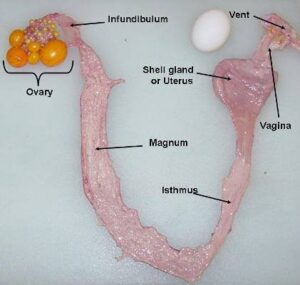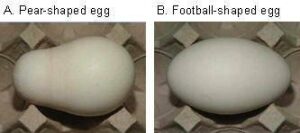Egg Irregularities in Layers
Various events can occur during reproduction that cause irregularities in eggs. Some of these irregularities affect the quality of the egg or consumer acceptance of the egg.
Chromium (Cr) and Copper (Cu) supplementation in laying hens improved their egg weight, specific gravity, shell thickness, weight and egg production. Chromium (Cr) and Copper (Cu) supplementation improved feed efficiency and subsequently the egg production was enhanced in laying hens.Cr augments egg quality by acting as a structural component of egg albumin or in cross linking of protein, necessary for the synthesis of ovomucin and facilitates the transfer of cation into the albumin of egg during the plumping process in the uterus. Increasing egg shell thickness may be due to the action of Cr which stimulates and control insulin action or indirectly empowers the ascorbic acid transportation which has significant role in formation of eggshell
If the vitelline membrane surrounding the yolk becomes damaged, pale spots or blotches develop on the yolk. This irregularity is referred to as mottling. Although the appearance of the yolk has changed, there is no effect on the egg’s nutritional value and typically the mottling is not noticed by consumers. A high incidence of yolk mottling, however, adversely affects consumer acceptance. The use of cottonseed meal (which contains gossypol) and sorghum (which contains tannin) in the diet can increase the incidence of mottling. A calcium-deficient diet also has this effect.
Occasionally, a hen produces double-yolked eggs. This phenomenon can be related to hen age, but genetic factors also are involved. Young hens sometimes release two yolks from the ovary in quick succession. Double-yolked eggs are typically larger in size than single-yolked eggs. Double-yolked eggs are not suitable for hatching as they typically have inadequate nutrients and space available for two chicks to fully develop and hatch. It has happened, but it is rare.
It is rare, but not impossible, for a young hen to produce an egg with no yolk at all. Yolk-less eggs (sometimes referred to as pullet eggs) are usually formed when a bit of tissue is sloughed off the ovary or oviduct. The tissue stimulates the secreting glands of the different parts of the oviduct, and a yolk-less egg results.
Even rarer is an egg within an egg. This occurs when an egg nearly ready to be laid reverses direction, moves up the oviduct, and encounters another egg in the process of forming. A new layer of albumen, new membranes, and a new shell form around the first egg, resulting in an egg inside an egg. Such eggs are so rare that no one knows exactly why they happen.
Other egg problems common when people raise their own chickens are blood spots (as shown in Figure 4) and meat spots. Blood spots are normally found on or around the yolk. The main cause of a blood spot is a small break in one of the tiny blood vessels around the yolk that occurs when the yolk is ovulated. High levels of hen activity during the time of ovulation can increase the incidence of blood spots. Meat spots are usually brown in color and are more often associated with the egg white. They form when small pieces of the wall of the oviduct are sloughed off while the developing egg is passing through. In commercial operations, eggs with blood spots and meat spots typically are identified during candling and removed (see Figure 5). It is rare, therefore, to find eggs with these irregularities in grocery stores. The incidence of blood spots is higher in brown-shelled eggs, and identifying blood spots when candling eggs with darker-colored shells is difficult.
Occasionally, a hen lays an egg without a shell. A shell-less egg feels like a water balloon. The shell membranes form around the yolk and egg white, but the egg somehow bypasses the shell-forming mechanism, and the shell is not completely deposited. The occurrence of the occasional shell-less egg is not necessarily an indication of health problems. If the incidence increases, however, a nutrition problem, primarily a deficiency of calcium, phosphorus, and/or vitamin D, may exist. If the condition persists, a veterinarian should examine the hen. Infectious bronchitis and egg drop syndrome also have been known to cause an increase in shell-less eggs.
Other problems can occur when an egg’s shell is developing. The most obvious relate to shell texture. Occasionally, the shell becomes damaged while the egg is in the shell gland and is repaired before the hen lays the egg. This repair results in what is known as a body check. Occasionally, thin spots in the shell or ridges form (see Figure 6). These shells are weaker than those of normal eggs, so eggs with thin spots are removed during inspection of table eggs and should not be used as hatching eggs.
The second category of problems relate to abnormal shape (see Figure 7). Eggs with abnormal shapes do not fit well into a typical egg carton or are more likely to break during transport, so they are removed during egg inspection and are not normally sold in stores. Hatching eggs also should have the typical egg shape. With many abnormally shaped eggs, it is not clear which is the large end, and eggs should be incubated large end up. Also, such eggs may not properly fit in the egg trays.





Reference-on request



